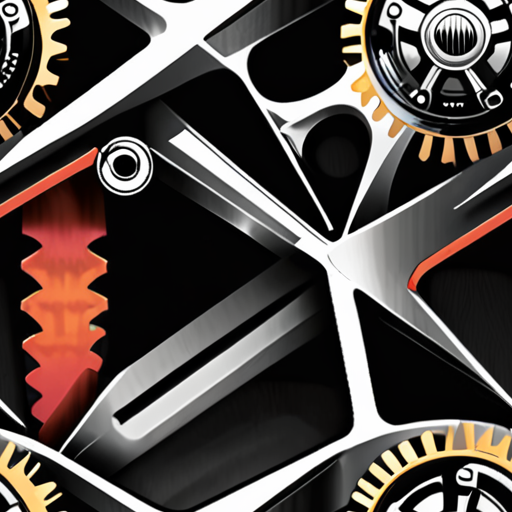When it comes to enhancing the performance and safety of your vehicle, one crucial aspect often overlooked is the correct wheel fitment. A wheel fitment chart serves as a vital tool in determining the ideal wheel size and offset for your vehicle, ensuring optimal tire fit and preventing potential issues that may arise from improper installation. By understanding the key factors to consider when selecting the right wheel size and offset, you can avoid common mistakes that may compromise your vehicle’s handling and safety.

Choosing the Right Wheels for Your Vehicle
At Incubus Wheels, we understand the importance of selecting the perfect wheels for your vehicle. With numerous options available, it can be overwhelming to decide which ones suit your needs.
- Measure Your Vehicle’s Rim Size: Before choosing a wheel, measure the diameter and width of your rim to ensure compatibility.
- Check the Bolt Pattern: Verify the bolt pattern of your vehicle’s hub to match it with the wheel’s lug pattern.
- Determine the Offset: Calculate the offset of your vehicle’s wheel to ensure proper clearance and alignment.
- Select the Correct Tire Size: Choose a tire size that matches your vehicle’s specifications to ensure optimal performance and safety.
Understanding Wheel Fitment Charts
A wheel fitment chart is a valuable tool that helps you select the correct wheels for your vehicle. These charts typically display various wheel sizes, offsets, and bolt patterns, allowing you to compare and contrast different options.
- Identify the Correct Wheel Size: Use the chart to find the recommended wheel size for your vehicle based on its make, model, and year.
- Check the Offset Range: Determine the acceptable offset range for your vehicle to ensure proper clearance and alignment.
- Bolt Pattern Compatibility: Verify that the wheel’s lug pattern matches your vehicle’s hub bolt pattern.
- Tire Size Compatibility: Ensure that the selected tire size is compatible with your vehicle’s specifications.
Additional Tips for Choosing the Perfect Wheels
In addition to using a wheel fitment chart, consider the following factors when selecting the perfect wheels for your vehicle:
- Style and Design: Choose a wheel style that complements your vehicle’s aesthetic.
- Material and Finish: Select a wheel material and finish that suits your preferences and budget.
- Load Rating: Ensure that the wheel’s load rating meets your vehicle’s requirements.
- Warranty and Support: Look for a reputable manufacturer that offers a comprehensive warranty and excellent customer support.
Learn More About Our Custom Wheels
Choosing the Right Wheel Size and Offset for Optimal Performance and Safety
When it comes to selecting the ideal wheel size and offset for your vehicle, there are several key factors to consider.
- Wheel Diameter: A larger wheel diameter can improve handling and braking performance, but may compromise ride comfort and increase the risk of tire damage.
- Offset: The offset refers to the distance between the center of the wheel and the hub mounting surface. A positive offset means the wheel is pushed out towards the fender, while a negative offset means it’s pulled in towards the hub.
- Tire Width: Wider tires can provide better traction and stability, but may reduce fuel efficiency and increase wear on suspension components.
- Load Rating: Make sure the wheel is rated for the weight of your vehicle, taking into account any heavy loads or passengers.
- Material: Choose a high-quality wheel material that can withstand the rigors of driving conditions, such as aluminum or forged steel.
- Finish: Select a finish that complements your vehicle’s aesthetic, such as chrome, gloss black, or matte.
Understanding Wheel Fitment Charts
A wheel fitment chart is a valuable tool for determining the correct wheel size and offset for your vehicle.
- Measure Your Vehicle’s Hub Bore: Use a caliper to measure the diameter of your vehicle’s hub bore.
- Determine Your Vehicle’s Wheel Offset: Check your vehicle’s owner’s manual or consult with a mechanic to determine the recommended wheel offset.
- Select the Correct Wheel Size: Choose a wheel size that matches your vehicle’s specifications, considering factors such as wheel diameter, width, and load rating.
- Verify the Wheel Fitment Chart: Double-check the wheel fitment chart to ensure the selected wheel size and offset match your vehicle’s requirements.
Best Practices for Wheel Selection
To ensure optimal performance and safety, follow these best practices when selecting wheels:
- Consult with a Mechanic: Get professional advice from a trusted mechanic or auto technician.
- Research Different Options: Explore various wheel sizes, offsets, and materials to find the best fit for your vehicle.
- Check Local Regulations: Familiarize yourself with local laws and regulations regarding wheel size and offset.
- Consider Your Driving Style: Think about your driving habits and preferences when choosing wheels.
Additional Resources
For more information on wheel selection and fitment, visit the following resources:
Wheel Industry Association Tire Rack Hangzhou ZongShen
Choosing the Right Wheel Size and Offset: Common Mistakes to Avoid
When selecting the perfect set of wheels for your vehicle, there are several factors to consider, including wheel size and offset.
- Wheel Size: A larger wheel size may look impressive, but it can compromise handling and braking performance. Make sure to choose a wheel size that matches your vehicle’s specifications.
- Offset: The offset refers to the distance between the center of the wheel and its mounting surface. An incorrect offset can cause uneven tire wear, reduced traction, and compromised safety features.
- Clearance: Ensure that the chosen wheel has sufficient clearance to accommodate the brake caliper and other components.
- Tire Size: Select a tire size that complements the wheel size and ensures optimal performance.
The Importance of a Wheel Fitment Chart
A wheel fitment chart is a valuable resource that helps you determine the correct wheel size and offset for your vehicle. By consulting a wheel fitment chart, you can avoid costly mistakes and ensure a smooth upgrade process.
- Accurate Measurements: A wheel fitment chart provides precise measurements, allowing you to select the ideal wheel size and offset for your vehicle.
- Compatibility Check: The chart helps you verify compatibility between the wheel and your vehicle’s suspension, steering, and brakes.
- Tire Selection: With a wheel fitment chart, you can easily find the perfect tire size to match your chosen wheel.
How to Use a Wheel Fitment Chart Effectively
To get the most out of a wheel fitment chart, follow these steps:
- Select Your Vehicle: Choose your vehicle make, model, and year to access the relevant wheel fitment chart.
- Enter Your Specifications: Input your wheel size, offset, and other relevant details to receive accurate recommendations.
- Review and Compare: Carefully review the chart’s suggestions and compare them to your original selection to ensure accuracy.
- Verify Compatibility: Double-check the chart’s compatibility check to confirm that the selected wheel meets your vehicle’s requirements.
Benefits of Using a Wheel Fitment Chart
By utilizing a wheel fitment chart, you can enjoy numerous benefits, including:
- Improved Safety: Accurate wheel sizing and offset ensure optimal performance and reduce the risk of accidents.
- Increased Efficiency: A wheel fitment chart saves you time and effort by streamlining the upgrade process.
- Cost Savings: Avoid costly mistakes and unnecessary repairs by selecting the correct wheel size and offset.
Conclusion is Not Required

Essential Measurements to Look for on a Wheel Fitment Chart
To ensure proper tire fit and optimal vehicle performance, it’s crucial to understand the key measurements on a wheel fitment chart.
- Bolt Pattern: Also known as the lug pattern, this measurement indicates the number and arrangement of bolts on the wheel hub.
- Center Bore: This measures the diameter of the center hole in the wheel, which must match the hub bore size of the vehicle.
- Offset: Measured in millimeters, offset determines how far the wheel is positioned from the hub mounting surface.
- Wheel Diameter: This measures the overall diameter of the wheel, including the rim and tire.
- Tire Size: This refers to the tire’s width, aspect ratio, and construction type (e.g., RFT, run-flat tire).
- Load Rating: This measures the maximum weight capacity of the tire, usually indicated by a letter rating (e.g., H, V, W).
- This measures the maximum speed at which the tire can safely operate, usually indicated by a letter rating (e.g., Q, R, S).
When selecting wheels, consider factors such as vehicle make and model, driving style, and intended use. Consult the manufacturer’s recommendations and consult with a professional fitter if unsure.
Understanding Wheel Fitment Charts
A well-designed wheel fitment chart should include the following information:
- Wheel specifications: Including bolt pattern, center bore, offset, and wheel diameter.
- Tire specifications: Including tire size, load rating, and speed rating.
- Vehicle compatibility: Including make, model, and year.
- Clearance and interference checks: To ensure proper clearance between the wheel and surrounding components.
Best Practices for Wheel Selection
When choosing wheels, remember to:
- Check vehicle manufacturer recommendations: Ensure the selected wheels meet or exceed OEM standards.
- Consider driving style and terrain: Select wheels suitable for your driving habits and environment.
- Verify tire compatibility: Ensure the selected tires are compatible with the chosen wheels.
- Consult professionals: If unsure, consult with a professional fitter or wheel specialist.
Reading and Interpreting a Wheel Fitment Chart
To ensure accurate tire selection and optimal vehicle performance, understanding how to read and interpret a wheel fitment chart is crucial.
- Step 1: Identify the Key Components
- Tire size and type
- Wheel diameter and width
- Bolt pattern and lug nut size
- Offset and center bore
- Step 2: Determine the Bolt Pattern
- Common bolt patterns include 4×100, 4×114.3, and 5×120
- Verify the bolt pattern on your vehicle’s wheel hub to ensure compatibility with the selected wheels
- Step 3: Check the Offset and Center Bore
- Positive offset means the hub is positioned closer to the front of the wheel
- Negative offset means the hub is positioned closer to the rear of the wheel
- Center bore refers to the diameter of the hole in the center of the wheel
- Verify the offset and center bore specifications to ensure compatibility with the selected wheels
- Step 4: Select the Correct Tires
- Tire size and type (e.g., all-season, high-performance)
- Load rating and speed rating
- Tread pattern and depth
- Step 5: Verify Compatibility
- Consult the owner’s manual or manufacturer’s website for specific requirements
- Verify the wheel and tire dimensions, bolt pattern, and offset specifications
- Tire Rack
- Wheel Industries
- Hangsterfer
A wheel fitment chart typically consists of several key components, including:
Familiarize yourself with these components to accurately select the correct tires and wheels for your vehicle.
The bolt pattern refers to the arrangement of the lug nuts on the wheel hub.
The offset refers to the distance between the wheel’s hub mounting surface and its centerline.
With the key components identified, select the correct tires based on the following factors:
Consult the manufacturer’s recommendations and consider factors such as driving habits, climate, and terrain to choose the most suitable tires.
Double-check the compatibility of the selected wheels and tires with your vehicle’s make and model.
By following these steps, you can ensure accurate tire selection and optimal vehicle performance through proper interpretation of a wheel fitment chart.
Additional Resources:
For more information on wheel fitment charts and tire selection, visit the following resources:

Mastering Wheel Size and Offset with a Comprehensive Wheel Fitment Chart
At Incubus Wheels, we understand the importance of finding the perfect wheel size and offset for your vehicle.
- Determine your vehicle’s make and model to find its recommended wheel size and offset range.
- Measure your vehicle’s wheel wells and brake calipers to determine the maximum clearance available for larger wheels.
- Consider the type of driving you’ll be doing most often, such as street driving or off-roading, to determine the necessary wheel strength and durability.
- Research different wheel designs and materials to find the one that suits your needs and budget.
- Consult with a professional mechanic or wheel technician to ensure a proper fit and installation.
Key Measurements to Consider:
- Wheel diameter: Measure the diameter of your vehicle’s original wheels to determine the correct replacement size.
- Offset: Determine the correct offset for your vehicle based on its make and model, as well as the type of driving you’ll be doing.
- Backspace: Measure the distance between the wheel hub and the back of the wheel to ensure proper clearance.
- Center bore: Verify the center bore of your vehicle’s hubs matches the center bore of your new wheels.
- Hub bore: Check the hub bore of your vehicle’s hubs to ensure compatibility with your new wheels.
Comprehensive Wheel Fitment Chart:
A wheel fitment chart is a valuable tool for determining the correct wheel size and offset for your vehicle.
- Look for charts that include a variety of wheel sizes and offsets to accommodate different vehicle makes and models.
- Check the chart for recommended wheel sizes and offsets based on the type of driving you’ll be doing.
- Verify the chart includes information on wheel strength and durability to ensure the correct choice for your needs.
- Consult with a professional mechanic or wheel technician to interpret the chart and ensure a proper fit and installation.
Conclusion:
By considering these key measurements and consulting a comprehensive wheel fitment chart, you can ensure a perfect fit for your vehicle’s wheels and enjoy improved performance, handling, and style.

0 Comments